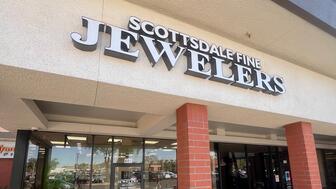Sponsored by the Gemological Institute of America
Pandora to Buy Back Inventory, Cut Size of Sell-In Package
It’s part of the beleaguered bead brand’s effort to turn the company around.

Copenhagen, Denmark—Buying back inventory from wholesale partners and cutting back on both promotions and the size of sell-in packages are a few of the pieces of Pandora’s two-year turnaround plan.
Called Programme NOW and initially introduced in November, the plan’s next steps were outlined in detail Tuesday as Pandora also laid out what ails the company.
The list of problems detailed likely will not surprise any jeweler who carries—or carried—the bead brand.
Pandora acknowledged that it has high brand awareness but no real identity.
Consumers are no longer excited by its beads, which it said are the “backbone” of the company.
That, in turn, has forced it to hold more sales to get rid of product that’s not moving—training consumers to never buy at full price—and left stores with a “cluttered assortment presentation” and a “build-up of inventory,” Pandora said.
In 2019, the Copenhagen-based company said it will cut back on the number of promotions between major gift-giving holidays and initiate an inventory buyback program in selected markets.
Though details on the buyback program are still being worked out, a Pandora spokesman told National Jeweler that the United States would be among those “selected markets” but the inventory “cleanup” will not be nearly as large as the buyback conducted in 2011-2012.
“It is also certain,” he noted, “that we will rely on our partners to jointly solve the challenge … As always, the U.S. will continue to do a garden cleaning in the spring as they have always done. Additional garden cleaning will be determined based on stock levels at a later date.”
Pandora also will reduce the price of its sell-in packages for retailers by 20 to 30 percent on average.
The plans announced earlier this week followed the November news that Pandora will pull back on concept store openings and stop buying back franchises from retailers.
In an interview published Feb. 1, Sid Keswani, the new head of the Americas for Pandora, told JCKOnline.com that the company considers its franchisees to be its “strong partners,” an apparent shift in strategy for a company once intent on cutting out retailers and running as much of its global store network as possible.
Also planned for 2019 are a rebranding, new advertising campaign, another new bracelet following the fall 2018 introduction of “Reflextions,” creation of an online bracelet builder and the debut of a new store concept.
The bead and jewelry brand saw worldwide like-for-like sales slip 4 percent year-over-year, including a 7 percent drop in the fourth quarter.
Total sales hit DKK 22.8 billion ($3.47 billion), up 3 percent year-over-year.
In the U.S., which is Pandora’s largest market, like-for-like sales were flat while total sales declined 5 percent to DKK 4.88 billion ($743.2 million).
New concept stores—Pandora opened 67 in the U.S. last year—and online sales drove revenue, while physical stores continued to struggle and jewelers who carry Pandora either cut back on their inventory or dropped the brand entirely.
The Copenhagen-based company forecasts a revenue decline of 3 to 7 percent for 2019.
The Latest

Simon Wolf shares why the time was right to open a new office here, what he looks for in a retail partner, and why he loves U.S. consumers.

A third-generation jeweler, Ginsberg worked at his family’s store, Ginsberg Jewelers, from 1948 until his retirement in 2019.

The risk of laboratory-grown diamonds being falsely presented as natural diamonds presents a very significant danger to consumer trust.

The organization also announced its board of directors.


Charms may be tiny but with their small size comes endless layering possibilities, from bracelets to necklaces and earrings.


Located in Valenza, the now 355,000-square-foot facility includes a new jewelry school that’s open to the public, Scuola Bulgari.

Paola Sasplugas, co-founder of the Barcelona-based jewelry brand, received the Fine Jewelry Award.

A platinum Zenith-powered Daytona commissioned in the late ‘90s will headline Sotheby’s Important Watches sale in Geneva next month.

The basketball stars wear men’s jewelry from the “Curb Chain” collection.

The Signet Jewelers-owned retailer wants to encourage younger shoppers to wear fine jewelry every day, not just on special occasions.

The 21 pieces, all from a private collector, will be offered at its Magnificent Jewels auction next month.

Lilian Raji answers a question from a reader who is looking to grow her jewelry business but has a limited marketing budget.

GCAL by Sarine created the new role to sharpen the company’s focus on strategic partnerships and scalable expansion.

The Indiana jeweler has acquired Scottsdale Fine Jewelers in Scottsdale, Arizona.

“Cartier: Design, Craft, and Legacy” opened earlier this month at the Victoria and Albert Museum in London.

Van Cott Jewelers in Vestal, New York, is hosting a going-out-of-business sale.

Industry veteran Samantha Larson has held leadership roles at Borsheims, McTeigue & McClelland, Stuller, and Long’s Jewelers.
The two organizations will hold the educational event together this fall in Mississippi.

The entrepreneur and “Shark Tank” star will share his top tips for success.

The Ukrainian brand’s new pendant is modeled after a traditional paska, a pastry often baked for Easter in Eastern European cultures.

The jeweler has announced a grand reopening for its recently remodeled location in Peoria, Illinois.

The “Strong Like Mom” campaign features moms who work at Tiffany & Co. and their children.

Interior designer Athena Calderone looked to decor from the 1920s and 1930s when crafting her first fine jewelry collection.

The free program provides educational content for jewelry salespeople and enthusiasts to learn or refresh their diamond knowledge.

The feedback will be used to prepare other jewelers for the challenges ahead, the organization said.



























